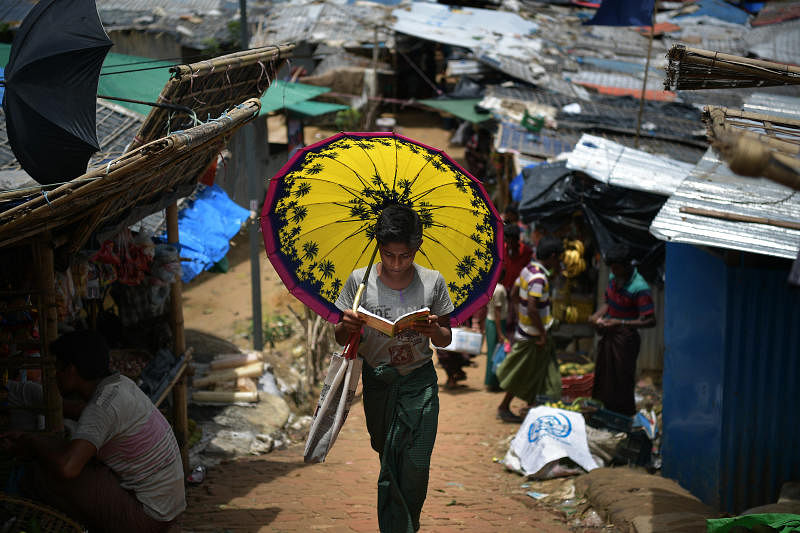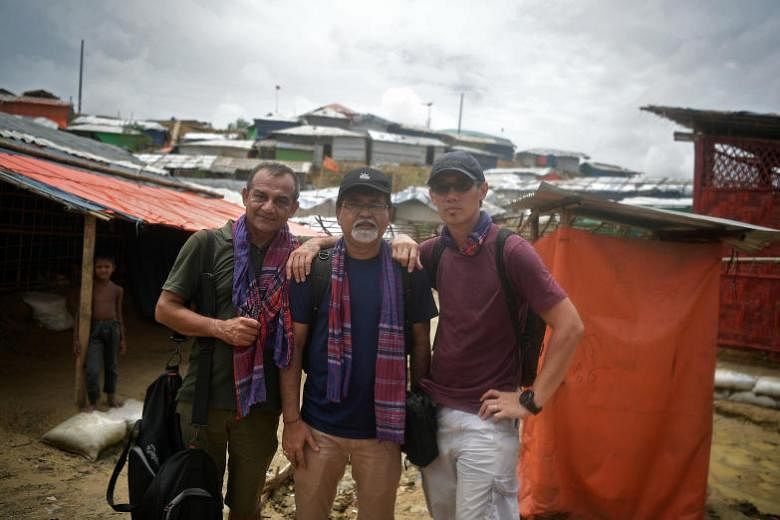SINGAPORE - The three journalists had walked through the Rohingya camps in Cox's Bazar, Bangladesh, more than nine hours each day, for nearly three days, when it struck them that something was not right.
There were nearly a million people in that cramped, makeshift township, and The Straits Times associate editor Rahul Pathak, executive photojournalist Kua Chee Siong and artist Pradip Sikdar had seen and spoken to hundreds of them. But where were all the teenage girls?
It took some more digging around to establish that while there were nearly 60,000 girls between the ages of 12 and 17 in the camps, their conservative community did not permit them to step out of their tiny huts - despite all the tragedy that had befallen them.
Their moving package of stories - on the unfortunate Rohingya girls, on children who had become heads of households because their parents had been killed, and on the suffocating life in the camps - has won the ST team the top place in the news or event feature category at the prestigious Editor & Publisher (EPPY) Awards.
ST's package tied for this top global award with a CNN feature on illegal executions in El Salvador.
Informing ST of the win, the EPPY Awards Committee chairman Martha McIntosh wrote: "The competition was fierce, there were hundreds of entries and the judges chose your submission as exemplifying the very best in its category."
Other winners this year include Bloomberg, The Boston Globe, USA Today and ESPN.com.
"The Rohingya crisis is a major humanitarian issue playing out in our backyard and we wanted to bring this story home to our audience. Credit to Rahul, Chee Siong, Pradip and the team for the gripping stories and pictures they came back with," said Mr Warren Fernandez, ST editor and editor-in-chief of the English/Malay/Tamil Media group.
"Their accounts were heart-wrenching and helped many readers to grasp the full extent of the suffering on the ground in Cox's Bazar."
In all, the ST team spent nine days in Bangladesh in late July this year to curate a first-hand account of the day-to-day existence of the Rohingya refugees in camps there.
The package comprised touching reports, gripping photographs as well as detailed inkwash drawings by Mr Sikdar, 52, who is now with Singapore Press Holdings' integrated marketing department as a senior art director.
"The existing spate of coverage was all about what the refugees underwent in Myanmar, but what we wanted was to detail the daily lives of a people who had been completely displaced," said Mr Pathak, 57.
He explained that an additional barrier in portraying the true plight of the Rohingya was that very few understood their dialect. The default option for international journalists was to turn to "fixers" who would offer to source for victims and translate what they said - for a fee.
ST decided against taking that route. "To treat these people like commodities whose stories can be sold cheapens their plight,' said Mr Pathak.
Instead, Mr Pathak would ask questions in English, Mr Sikdar would translate them into Bengali and a local journalist would then translate them into the Rohingya dialect. The answer would come back through the same route. "These were real answers from real people," said Mr Pathak.
Of all the photos Mr Kua, 44, took on the trip, his favourite was one of a boy with a yellow umbrella.

He explained: "It spoke a lot to me in terms of aesthetics and the complexity of the situation. The picture gives a sense of peace and beauty but this belies the monumental problems that they face."
This is ST's second year winning at the global annual EPPY Awards, which were launched in 1996 and honour the best media-affiliated websites across 30 categories. Last year, ST won its first EPPY Award for best website infographic.
This year, ST also had several other projects that were shortlisted in various categories:
- Best investigative/enterprise feature: No one dies alone
- Best innovation project: Asia's sacred art and The gender pay gap explained
- Best use of data/infographics: Malaysia's 14th general election
- Best editorial/political cartoon: Wary world watches as China plays peacemaker

- Best promotional/marketing campaign: ST Premium: It pays to know






